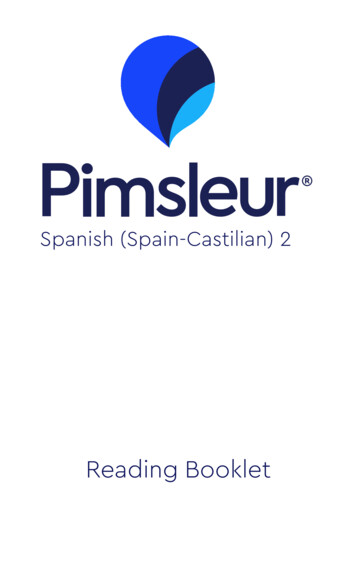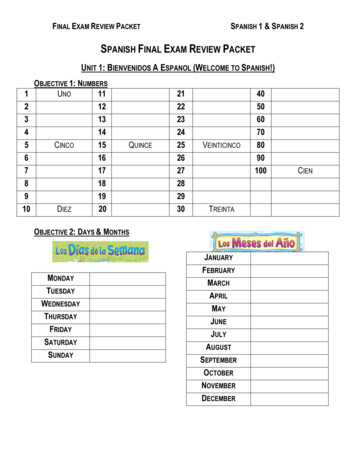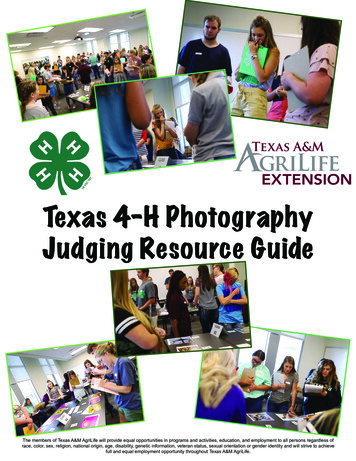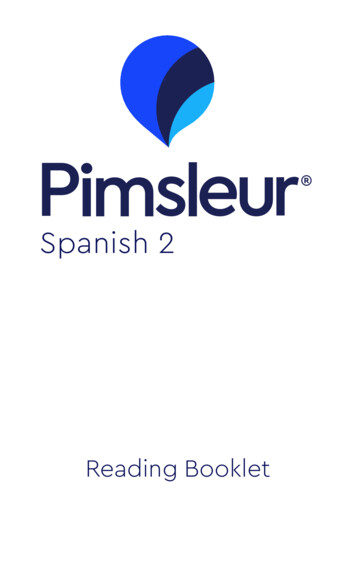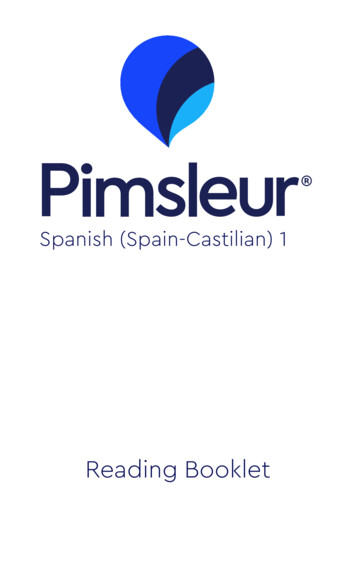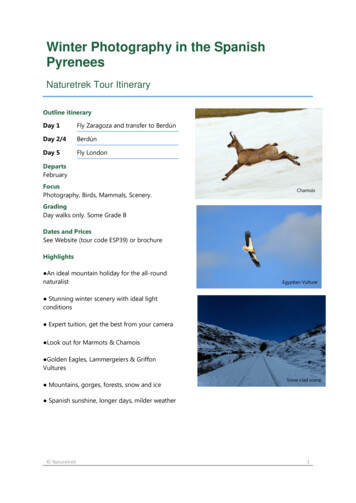
Transcription
Winter Photography in the SpanishPyreneesNaturetrek Tour ItineraryOutline itineraryDay 1Fly Zaragoza and transfer to BerdúnDay 2/4BerdúnDay 5Fly LondonDepartsFebruaryFocusPhotography, Birds, Mammals, Scenery.ChamoisGradingDay walks only. Some Grade BDates and PricesSee Website (tour code ESP39) or brochureHighlights An ideal mountain holiday for the all-roundnaturalistEgyptian Vulture Stunning winter scenery with ideal lightconditions Expert tuition, get the best from your camera Look out for Marmots & Chamois Golden Eagles, Lammergeiers & GriffonVultures Mountains, gorges, forests, snow and iceSnow clad scene Spanish sunshine, longer days, milder weather Naturetrek1
Wild Photography in the Spanish PyreneesTour ItineraryIntroductionThe scenery of the Spanish Pyrenees has agrandeur that attracts many visitors each year,but with photography as our focus on this new5-day holiday to rural Aragón we’ll view theregion’s stunning cliffs, canyons and limestoneerosions with a more artistic eye than thegeneral tourist. Aimed at beginners andintermediates, you will have a chance to honeyour wildlife and landscape photography skillsin a beautiful and unspoilt setting, withbreathtaking Pyrenean scenery as a backdropto your shots. The comfortable base for ouractivities is a delightful 300-year-old propertysituated in the pretty hilltop village of Berdúnwhich enjoys fine views of the Pyrenees,surrounding foothills, and valleys of the Veraland Aragón Rivers. Our friendly hosts will makeus most welcome, keeping us well fed on localcuisine, while our tutor will be experiencedlocal photographer Sergio Padura. Sergio fine-Snow shoeingtuned his artistic appreciation with a B.A. in ArtHistory at the University of Barcelona, as well as completing a 5-year course at the Institute ofPhotographic Studies of Catalonia. Now based in the Aragonese Pyrenees, he has travelled widely,and works as a professional photographer in a variety of different sectors from architecture tolandscape. He has an open, friendly manner and an excellent understanding of how to help peoplemake the most of their potential as a photographer, whatever level they start at. This tour isdesigned for those who want to learn more about the basics of photography and who also have akeen interest in nature.Advances in technology mean many of us now own digital SLR cameras. If you have becomeaccustomed to setting the dial to ‘AUTO’, and have forgotten or are only dimly aware of suchconcepts as focal length, aperture and shutter speed, but have the kit and are keen to learn (orremember) how to use it, this holiday offers such an opportunity. Sergio will teach you the basics,and more depending on how fast you progress, then head straight off outside each day to helpyou practice your new skills, with the natural beauty of the setting providing the backdrop ofscenery, birds, plants and butterflies that will be the subjects of the holiday. It is important to stress,however, that this holiday is about learning to take photographs, and not about your camera.Excellent results can be achieved with the simplest of cameras, and despite all the technical wizardryon offer, there is no substitute for a good eye, good subject matter and knowing how to make themost of the light.Winter Photography in the Spanish Pyrenees
Wild Photography in the Spanish PyreneesTour ItineraryWe aim to make the most of the mountain photography with the special winter sunshine of theSpanish Pyrenees at this time of year. The amazing light with the sun low in the sky all day longguarantees ideal photographic conditions against the backdrop of high snow-clad peaks, dramaticgorges, mountain forests and rushing rivers. We will explore some hidden locations known only toSergio in local Natural Parks, sometimes using snowshoes.Lammergeier, Griffon Vultures andGolden Eagles are permanent residents of the Pyrenees, while we coincide with the Crane, Lapwingand Black Kite migration. Accommodation and meals are at the excellent Casa Sarasa, where aftera long day in the field evening meals are taken by an open fire.NB. Please note that the itinerary below offers our planned programme of excursions.However, adverse weather & other local considerations can necessitate some re-ordering ofthe programme during the course of the tour, though this will always be done to maximisebest use of the time and weather conditions available.Day 1BerdunWe depart from London Stansted on a flight direct to Zaragoza. From the airport we will pick upour hired minibuses and continue on to Berdun, stopping en route if time allows and shouldanything of interest be sighted.Previous journeys have certainlyoffered us a good variety of birds ofprey, as well as spectacular scenery.Berdun is a spectacular old hilltopvillage,sittingamidstthefloodplains of the Aragon and Veralrivers,yetsurroundedbythemountains and foothills of theSpanish Pyrenees.Nearby is Jaca, once the capital ofBerdunthe kingdom of Aragon, now a small historic town situated in the Aragon Valley in the southernfoothills of the central Pyrenees. The town has a 15th century fort and an interesting 11th CenturyRomanesque cathedral - the first indeed to be built in that style surrounded by a maze of medievalstreets.Day 2-4BerdunOver the following days we explore the Hecho, Ansó and Aisa valleys. We start every morning witha brief classroom session during which Sergio outlines the photographic objectives of the day,making sure that we’ll know the settings on the camera and the phototgraphic opportunities weWinter Photography in the Spanish Pyrenees
Wild Photography in the Spanish PyreneesTour Itineraryare likely to come across. Every day we drive for about 40 minutes to our destination, then we getspend time in the field to take pictures in the Parque Natural de los Valles Occidentales (The NaturalPark of the Western Valleys). Covering more than 27,000 hectares, with altitudes ranging from 900to 2,700m, it is an unspoilt mountain reserve where nobody ventures in winter. There are no skiresorts, no villages, no through roads, no power lines – just wilderness. Atlantic mixed forest, highuplands, rocky cliffs, deep gorges – the park encompasses a whole range and variety of habitatsand scenery. Home to several breeding pairs of Lammergeiers, whose chicks will be hatching at thebeginning of February, while Golden Eagles, Griffon Vultures, Snowfinches and Chamois seekrefuge in the lower wooded slopes and are relatively accessible. To make the most of the mountainswe will head out on snowshoes on one day, pacing through untouched snow to find a perfectvantage point for the perfect winter photograph. On other occasions we’ll try to capture thesunlight catching a nearby peak, the reflections from icicle-covered trees, or the rushing movementof a mountain river plunging through snow-covered rocks. On at least one occasion we’ll headoutdoors after dark to capture the moonlight on the snow or the brilliant winter stars. At the endof the day we head down to the milder climate of Berdún where at Casa Sarasa, Melanie will haveprepared a warming supper by the open fire. We will spend a while going through the day’s pictureswith Sergio for those that wish, before heading off to bed, full of ideas for the next day’s session.The end of February is migrationseason through the Pyrenees forCranes, Lapwings and Black Kites.The Cranes gather at the nearbySotonera and Yesa reservoirs,waitingforidealweatherconditions before attempting tocross the Pyrenees. Flying in theirdistinctiveVformations,sometimes thousands at a time,they circle over Berdún, gainingheight, before turning north andattempting to cross into France.Less spectacular, but just asreliable are the flocks of hundreds of Lapwings that head over the Western Pyrenees at this timeof year, while Black Kites in a less organised manner, go up the valleys and over the peaks. Downin the Aragón valley around Berdún, we’ll find the first of the migratory birds putting in appearances– huge flocks of Chaffinches, Starlings and Meadow Pipits hang around the fields, while it’s easy tofind Hawfinch, Bullfinch and Nuthatch at the birdfeeders in the garden of Casa Sarasa. The nearbyFoz de Binies is a great spot to find Wallcreeper at this time of year as they spend the winter atlower altitudes before heading up to the high mountains to breed.Winter Photography in the Spanish Pyrenees
Wild Photography in the Spanish PyreneesTour ItineraryBoth Lammergeiers, Griffon Vultures, Golden Eagles, Buzzards, Choughs, Alpine Choughs, andother high altitude species can be seen whilst exploring the areas and the valley's peaceful andremote location makes it a haven for large numbers of Alpine Marmots and the Pyrenean race ofthe Chamois - the Izard.A walk through the woodland usually produces Short-toed Treecreeper, Firecrest and Crested Titwhile Citril Finch and Black Woodpecker can be seen with some luck. It is a wonderful area toexplore with superb wildlife, scenery and countless photographic opportunities!Day 5Berdun to LondonWe must rise early this morning for the drive to the airport to check in for our flight back to London.It is likely that we will arrive back at London in the early afternoon.Trek gradingFrom our outstanding base in Berdun we willexplore both the foothills and mountains of theSpanish Pyrenees on daily outings, enjoyingtheir natural history by means of gentle daywalks. Our pace will be slow, as we look for birdsand mammals and of course take manyphotographs. We shall aim to be outdoors asmuch as possible covering perhaps between 4to 5 miles each day. This holiday should suitthose of all ages who enjoy natural history andmountain environments. Walks will of coursevary in severity with some steeper than othersbut we will move at a gentle pace with regularstops of course.WeatherAlthough around Berdun is often more mild than the UK in February, conditions can indeed bevery cold particularly when up in the mountains. For this tour warm winter clothing is essential,including hat and gloves. Footwear must be suitable for standing in the snow for a couple of hoursat a time, and it may be a good idea to bring two pairs of boots. The snowshoeing does requiresome physical effort, but would present no difficulty to anyone capable of a 5 mile walk. There isno need for any special camera equipment, although a tripod is always useful.Winter Photography in the Spanish Pyrenees
Wild Photography in the Spanish PyreneesTour ItineraryFood & accommodationAll food and accommodation is included in the price of this holiday.How to book your placeIn order to book your place on this holiday, please give us a call on 01962 733051 with a credit ordebit card, book online at www.naturetrek.co.uk, or alternatively complete and post the bookingform at the back of our main Naturetrek brochure, together with a deposit of 20% of the holidaycost plus any room supplements if required. If you do not have a copy of the brochure, please callus on 01962 733051 or request one via our website. Please stipulate any special requirements, forexample extension requests or connecting/regional flights, at the time of booking.Our picturesque accommodation in Berdun (Photostaken in Spring)Winter Photography in the Spanish Pyrenees
Aimed at beginners and intermediates, you will have a chance to hone your wildlife and landscape photography skills in a beautiful and unspoilt setting, with . Wild Photography in the Spanish Pyrenees Tour Itinerary Winter Photography in the Spanish Pyrenees Both Lammergeiers, Griffon Vultures, Golden Eagles, Buzzards, Choughs, Alpine Choughs .
